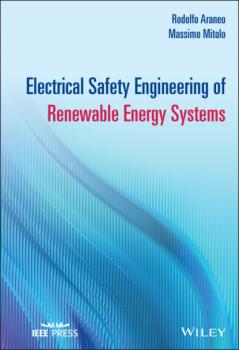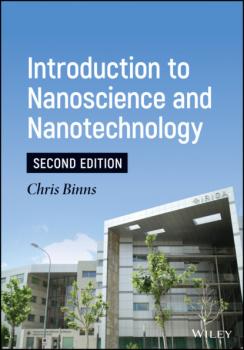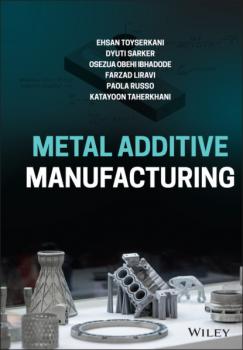John Wiley & Sons Limited
Все книги издательства John Wiley & Sons LimitedElectrical Safety Engineering of Renewable Energy Systems
Electrical Safety Engineering of Renewable Energy Systems A reference to designing and developing electrical systems connected to renewable energies Electrical Safety Engineering of Renewable Energy Systems is an authoritative text that offers an in-depth exploration to the safety challenges of renewable systems. The authors—noted experts on the topic—cover a wide-range of renewable systems including photovoltaic, wind, and cogeneration and propose a safety-by-design approach. The book clearly illustrates safe behavior in complex real-world renewable energy systems using practical approaches. The book contains a review of the foundational electrical engineering topics and highlights how safety engineering links to the renewable energies. Designed as an accessible resource, the text discusses the most relevant and current topics supported by rigorous analytical, theoretical and numerical analyses. The authors also provide guidelines for readers interested in practical applications. This important book: Reviews of the major electrical engineering topics Shows how safety engineering links to the renewable energies Discusses the most relevant current topics in the field Provides solid theoretical and numerical explanations Written for students and professional electrical engineers, Electrical Safety Engineering of Renewable Energy Systems explores the safety challenges of renewable systems and proposes a safety-by-design approach, which is currently missing in current literature.
Physics of Thin-Film Photovoltaics
It appears rather paradoxical that thin-film photovoltaics (PVs) are made of materials that seem unacceptable from the classical PV perspective, and yet they often outperform classical PV. This exciting new volume solves that paradox by switching to a new physics paradigm. Many concepts here fall beyond the classical PV scope. The differences lie in device thinness (microns instead of millimeters) and morphology (non-crystalline instead of crystalline). In such structures, the charge carriers can reach electrodes without recombination. On the other hand, thin disordered structures render a possibility of detrimental lateral nonuniformities (“recombination highways”), and their energy spectra give rise to new recombination modes. The mechanisms of thermal exchange and device degradation are correspondingly unique. The overall objective of this book is to give a self-contained in-depth discussion of the physics of thin-film systems in a manner accessible to both researchers and students. It covers most aspects of the physics of thin-film PV, including device operations, material structure and parameters, thin-film junction formation, analytical and numerical modeling, concepts of large area effects and lateral non-uniformities, physics of shunting (both shunt growth and effects), and device degradation. Also, it reviews a variety of physical diagnostic techniques proven with thin-film PV. Whether for the veteran engineer or the student, this is a must-have for any library.
Introduction to Nanoscience and Nanotechnology
The book presents nanoscience and nanotechnology to a broad audience that does not necessarily have a scientific background. This book starts with the fundamental physicochemical properties of nanoparticles and nanostructures, and discusses how these special properties can be manipulated to produce high-performance materials and devices. In the following chapters, the scope is broadened to cover naturally occurring nanoparticles and artificially-engineered carbon nanoparticles, their mechanical properties, and their importance to the rest of nanotechnology. The book also covers the two design ideologies for manufacturing nanostructures, the <i>bottom-up</i> and <i>top-down</i> methods, and discusses how these two can be combined to allow for the imaging, probing and manipulation of nanostructures. The remainder of the book surveys the current state of nanotechnology, including the use of single-nanoparticle devices in data storage, electronics, optics, and solar power; advances in nanoparticle manufacturing and biotechnology that can lead to powerful new cancer treatments; and the use of nanotechnology to study the “quantum vacuum”.
Metal Additive Manufacturing
METAL ADDITIVE MANUFACTURING A comprehensive review of additive manufacturing processes for metallic structures Additive Manufacturing (AM)—also commonly referred to as 3D printing—builds three-dimensional objects by adding materials layer by layer. Recent years have seen unprecedented investment in additive manufacturing research and development by governments and corporations worldwide. This technology has the potential to replace many conventional manufacturing processes, enable the development of new industry practices, and transform the entire manufacturing enterprise. Metal Additive Manufacturing provides an up-to-date review of all essential physics of metal additive manufacturing techniques with emphasis on both laser-based and non-laser-based additive manufacturing processes. This comprehensive volume covers fundamental processes and equipment, governing physics and modelling, design and topology optimization, and more. The text adresses introductory, intermediate, and advanced topics ranging from basic additive manufacturing process classification to practical and material design aspects of additive manufacturability. Written by a panel of expert authors in the field, this authoritative resource: Provides a thorough analysis of AM processes and their theoretical foundations Explains the classification, advantages, and applications of AM processes Describes the equipment required for different AM processes for metallic structures, including laser technologies, positioning devices, feeder and spreader mechanisms, and CAD software Discusses the opportunities, challenges, and current and emerging trends within the field Covers practical considerations, including design for AM, safety, quality assurance, automation, and real-time control of AM processes Includes illustrative cases studies and numerous figures and tables Featuring material drawn from the lead author’s research and professional experience on laser additive manufacturing, Metal Additive Manufacturing is an important source for manufacturing professionals, research and development engineers in the additive industry, and students and researchers involved in mechanical, mechatronics, automatic control, and materials engineering and science.









